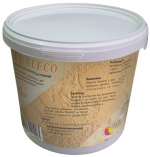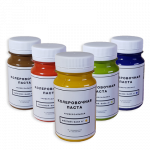Riviera



Price: 6400 rubl.
Package: 25 kilos.
+ additional 5% discount when ordering from 50,000 rubles
+ additional 15% discount when ordering from 100,000 rubles
+ additional 20% discount when ordering from 200,000 rubles
Get a 50% discount on dealership terms
Short description:
Textured plaster imitating the surface covered with aged wallpaper. For internal or external use.
Usage amount:
~1 kilo per 1 square meter (1 layer application)
Also purchases this product:
Riviera textured plaster is a decorative material with a filling of cellulose and acrylic elements, the binding elements and marble dust, which are the main components of this material.
Riviera has a unique plastic texture with nice porous pattern. It opens wide field of possibilities for use with different application techniques. Also it can be used to create complicated patterns and bas-reliefs with this type of material.
Riviera the decorative plaster – review
Has anyone ever used Riviera, a textured plaster with cellulose filling? It contains of acrylic elements and marble dust, which are the main elements of this material. Riviera plaster has nice porous pattern with firm structure when applied. This type of plaster lets it use with different application techniques. This material is used to create different bas-reliefs with complicated pattern.
Decorative material and its compounds
As mentioned before, Riviera consists of acrylic component and marble dust with an addition on cellulose. In this case acrylic components are used for binding purposes. When applied in 1 thick layer or with 2 thinner ones, the usage is about 1 kilo per square meter. This material can be used to create the cover from 1 to 70 centimeters thick. The package is 15 or 25 kilos. It would be preferable for the package to be larger, but the manufacturer probably doesn’t consider this option to be profitable, well, I wish they had it in larger packages.
Riviera is known to be used since the ancient Roman times when artisans only used two components – cellulose and water. These components were mixed and boiled together. The blend became homogenous and sticky, and was used for decorative purposes. In Mesopotamia similar blend was used for warming of their houses.
As years went by, the Egyptian masters perfected the decorative blend by adding marble dust left after stone processing. Hence, they have perfected Riviera plaster adding scents and wooden resin to it. Having created new type of plaster, Egyptian masters started using different techniques for creating bas-reliefs. This is how the appearance of mural decoration changed.
These artisans created the formula, which lets the ancient decorations still look fine even in our days. It can be seen even in our time on ancient buildings as main material, which has been used as borders of fresco of the most famous artists.
WoWColor variety of plasters.
Different types of plasters with different components are used today. They differ by the binding element. Hence, this type of material can be categorized into several groups:
— Acrylic plasters. With acrylic resins as binding element.
— Mineral plasters. With small amount of acrylic resins and limestone. This type is most firm and high-quality.
— Silicate plasters. With liquid potassium glass as a component.
— Silicone plasters. With silicone resin as a component. Mostly for exterior use.
History of Riviera plaster.
This material has been known to us since times when this plaster had no name at all, and its contents were different from the contemporary ones. If you return to the XVI century, you can trace its application technique in decoration. If we look even deeper in the past, we can see that Riviera has been used even earlier in time.
Archeology firmly states that decorative plasters have been widely used at the times of ancient civilizations. As studies show, this material has been used as mural decoration in ancient Egypt and Mesopotamia. The first appearance of brick, decorative materials, and solutions date back to these ancient times.
If you look at buildings in Venice or St. Petersburg palaces, you would never think that this glamour has been created by artisans of old days. No reconstruction or redecoration is needed to be done to these buildings. They blind us with their perfection, time is powerless to them. Having been here for such a long time, they haven’t changed even a bit and still are as beautiful and constant.
Riviera decorative plaster has its roots in ancient centuries. We have traced and the history of this material from ancient times up to contemporary time. When many years go by, this material will tell its story to our children and grandchildren too.
How is the surface prepared before applying Riviera material?
According to the master plan of your redecoration, the first step you have to take is preparing the walls as for wallpaper. This is important, because possible flaws of the surface may spoil the result. This material is very demanding to the quality of surface preparation. It’s better not to avoid this step even considering the fact that Riviera is usually applied in a thick layer and is able to mask all flaws and cracks. Besides that, this preparation would allow you to decrease the amount of material used per square meter. It’s also better to gain homogenous and high-quality pattern. And this is the first-priority task.
The price of application of plaster may vary depending on the project. First thing to do is to understand the current condition of the walls, its space, the workload and functionality of the object. The artisan’s experience is also meaningful when calculating the cost. What also matters is their experience and the demand for these workers on the redecoration market.


































